Sony Xperia 1 ii review: Sony’s best phone in years
The company is at its best when it stops trying to please everyone.
Looking back at our original Xperia 1 review, I’m embarrassed to say I missed the mark. Yes, it wasn’t “sensible”, but it was Sony’s first attempt at building a phone that elevated the camera experience above everything else. Of course that wasn’t going to make sense for most people.
Rather than revamp everything with the mainstream in mind, that phone's successor -- the $1,200 Xperia 1 ii -- is even more of a niche device. Once again, Sony drew from its expertise in pro-grade cameras, resulting in a phone that feels like a love letter to creative types and very few others. The difference is, that uneven focus actually works this time. The Xperia 1 ii (pronounced "One mark two," in a nod to its A-series cameras) is Sony's best phone in years because of its very specific obsessions. It won't do much for people who don't demand fine-grained detail, but if creative control is what you're after, the 1 ii sparks joy in a way no other phone will.
Key specs
| |
|---|---|
Processor | Octa-core Snapdragon 865 |
RAM/storage | 8GB+256GB |
MicroSD card support | Yes, up to 1TB |
Main display | 6.5-inch OLED display |
Display resolution | 1644 x 3840 (21:9) |
Rear cameras | 12MP f/1.7 wide camera with OIS, 12MP f/2.2 ultra-wide camera (124° field of view), 12MP f/2.4 telephoto camera with OIS, time of flight sensor |
Front-facing camera | 8MP f/2.0 camera |
OS | Android 10 |
Battery | 4,000mAh |
Charging | USB-C, supports 21W fast charging and 11W wireless charging |
Dimensions | 165.1x71.1x7.6mm |
Weight | 181.4g |
Fingerprint sensor | Yes, side-mounted |
Waterproofing | Yes, rated IP68 |
NFC | Yes |
Headphone jack | Yes |
5G support | No (in the US) |
Reviewer’s note: The Xperia 1 ii will go on sale in the United States on July 24, it won’t be feature complete. Sony has said that it will release a software update shortly after launch that, among other things, improves battery usage, tweaks camera performance and adds the ability to shoot RAW photos. Since we're using the same software many people will when they crack open their new Xperias, we're comfortable calling this review complete, but we'll update this story as needed when the new software is available.
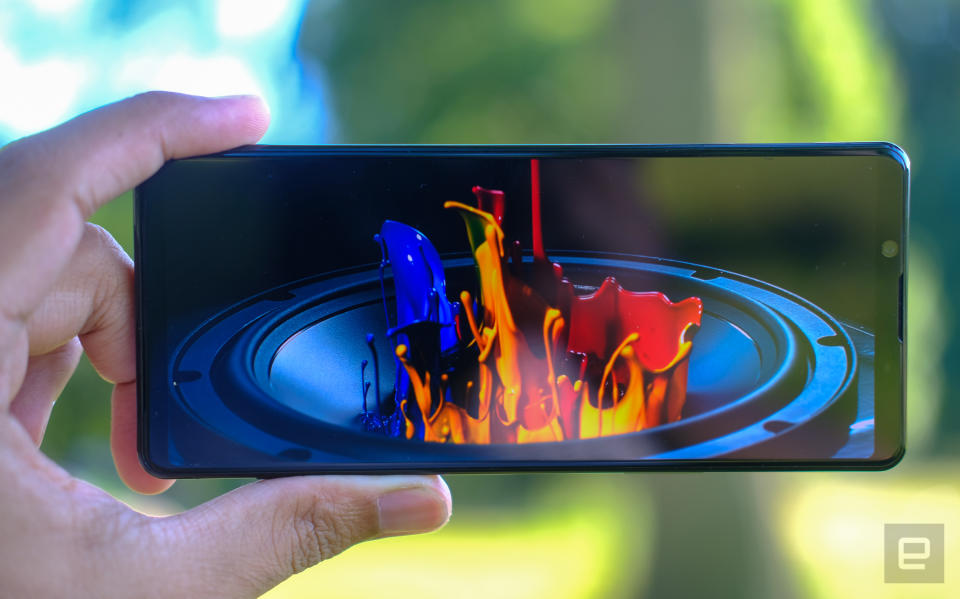
Cinematic hardware
The Xperia 1 ii looks very similar to last year's Xperia 1, which is to say it’s unusually long, like a remote control with glass where all those buttons would be. Sony's commitment to this design also means it used another slightly outlandish screen -- and I'm using the word "outlandish" as affectionately as possible.
Unlike just about every phone out there, the Xperia 1 ii has a full-blown, 6.5-inch 4K AMOLED display, which looks terrific when you're doing just about anything on it. And unlike other phones, this display has an aspect ratio of 21:9, making it more like a handheld movie screen. Ultra-wide cinematic videos shine here, though the 4:3 and 16:9 videos you'll find on YouTube and other streaming services will look a little awkward flanked by so much dead space.
A screen this different is bound to be divisive. People with small hands will find the screen tough to use without both hands, and we could debate for ages about whether anyone needs a smartphone with a 4K display. (My stance in a nutshell: "Nah.") The company also couldn't source a 4K display that refreshed at 90Hz or higher, but since those super-fast screens are all the rage, Sony tried to simulate the effect in software. It's a thoughtful addition, I suppose, but the effect is too subtle to notice.
By default, the phone's display is set to show off the kind of punchy, vibrant colors that people expect from OLED panels, but a "creator mode" strips them away in favor of a more subdued look meant to faithfully reproduce a "creator's intended vision." And if that wasn't enough, the phone offers granular control over the screen's white balance. These tweaks go a long way in making this screen appeal to cinephiles and auteurs, but they can't fix one annoying issue: The display is plenty bright for indoor use, but it frequently feels a little too dim outdoors.
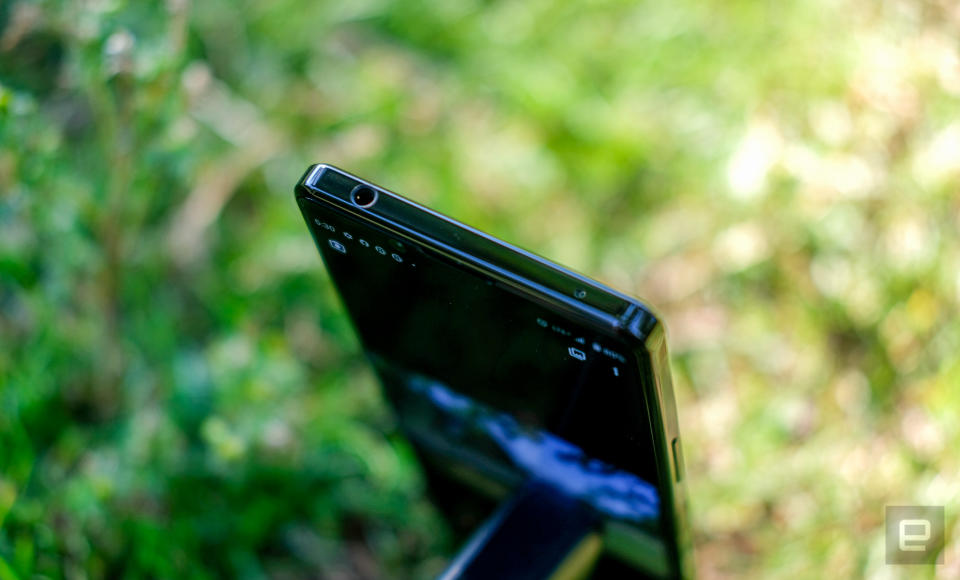
Most smartphone makers don’t give a damn about audio, but not Sony. The Xperia 1 ii's front-firing stereo speakers are a joy, that give soaring scores and jolting sound effects an almost palpable sense of “presence”. Even better, the Xperia 1 ii has a standard headphone jack up at the top. Sony also tried to augment its audio chops with a "Dynamic Vibration" feature that makes the phone rumble along with music and movie scenes, but don't bother. The effect is more annoying than anything and actually detracts from the audio experience rather than enhance it.
The rest of the phone is pretty typical Sony: It's maddeningly slippery (it basically demands a case), and it has a fingerprint sensor on its right edge that's quite helpful in an age of dutiful mask-wearing. Rather than force you to reach for a paperclip, you can access the SIM card tray by prying it out with a fingernail, and you can slip a microSD card in there too if the standard 256GB somehow isn't enough. And even better, that more accessible SIM tray doesn't affect the phone's dunkability -- it's rated IP68 for water and dust resistance. And, fittingly, there's a physical, two-stage shutter button that sits low on the Xperia's right side. Trust me: You'll be using it a lot.
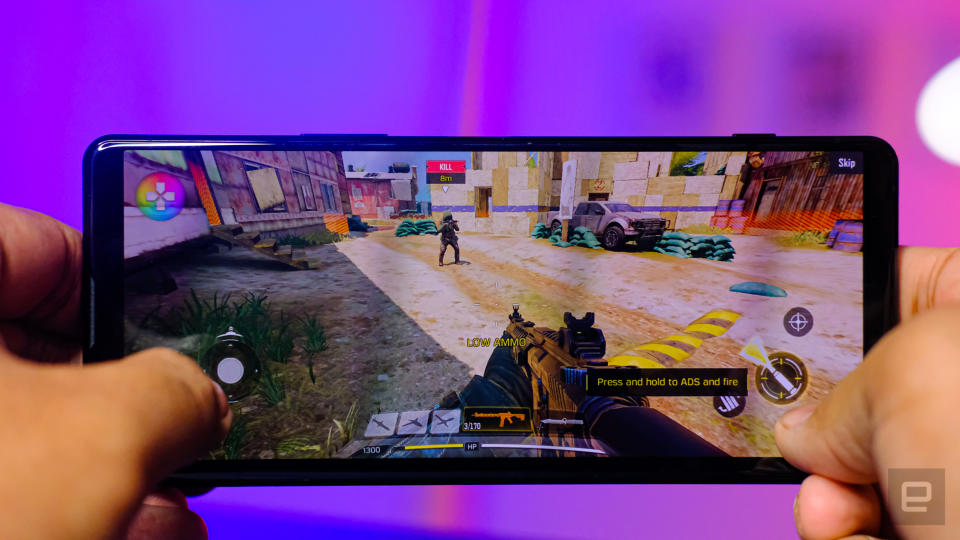
In use
It seems like Sony wanted to build a camera that does phone stuff instead of the other way around. Don't fret, though: When it comes to performance, the Xperia is every inch a flagship device. That's all thanks to its Snapdragon 865 chipset and 8GB of RAM, which has been more than enough to plow through workday multitasking and beautiful -- if ultimately embarrassing -- rounds of Call of Duty Mobile. In theory, it might not handle certain memory-intensive tasks as well as devices like the OnePlus 8 Pro or the Galaxy S20 series, which are both available with 12GB of RAM. But in reality, you'll have more than enough power to handle almost anything you need.
It doesn't hurt that Sony has a light touch when it comes to software. The Xperia runs a mostly clean version of Android 10, and what extra bits the company did add are surprisingly helpful. In addition to two pro-grade camera apps, there's one for streaming games from your PlayStation, an app that lets you remotely control a Sony Alpha camera, and Call of Duty just for fun. The only real stinker is Sony's News app, which looks cheesy, slips ads into its news feed, and frequently points to news outlets of questionable repute. If I wanted the US Sun’s take on Kanye's presidential run, I’d just go thumb through the tabloids in a checkout line.
A few other additions were designed to help you get the most out of the Xperia's oddly proportioned screen. One offers quick access to apps you can run in split-screen mode, in case you want to edit photos in Lightroom and keep a tutorial open in Chrome at the same time. Another -- SideSense -- launches a palette of shortcuts so you don't need to thumb through the full list in your launcher. Since it requires a fairly precise double-tap on the very edge of the screen, it's one of those features that's better on paper than in practice. After a week, I still can't reliably trigger it on my first try. More useful is the built-in One Hand mode — double-tapping the home button shrinks the screen and pushes it off to the side, making those far-off bits easier to reach with a thumb. Fortunately, I’ve been able to get by without it fairly easy, but this is a must-have for any small-handed cinematographers intrigued by the Xperia 1 ii.
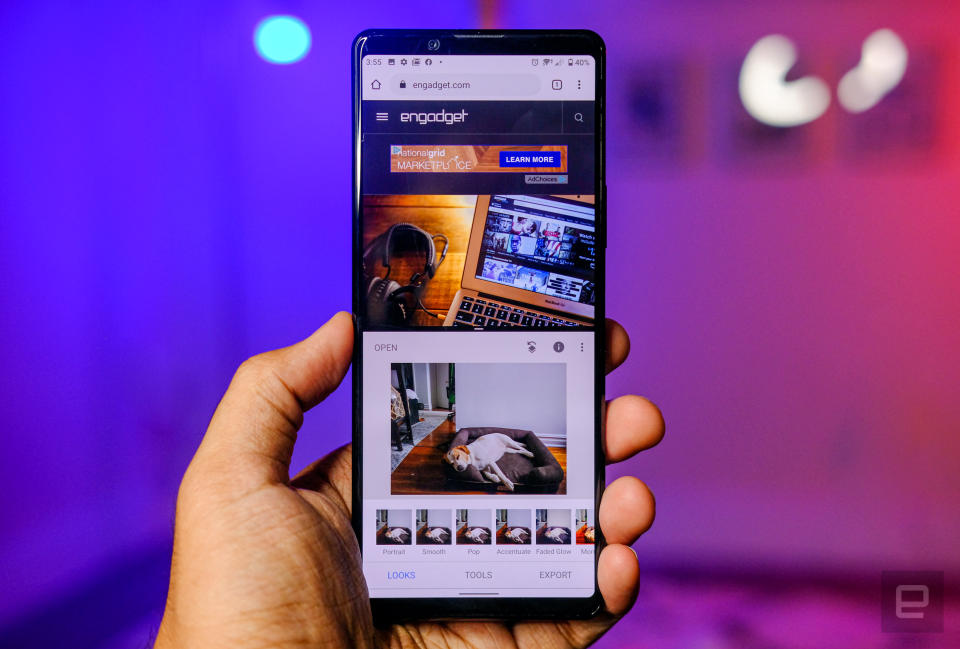
Overall, Sony did a great job here, pairing top-tier performance with clean, thoughtful software. But the Xperia's approach to 5G is a little puzzling. In Europe and Japan, where the phone is already on sale, the Xperia 1 ii plays nice with 5G NR networks. In the US, however, the Xperia lacks 5G support entirely. Well, "lacks" might be the wrong word. Sony has confirmed that the US hardware is identical to those other versions, so there's no reason why it can't latch onto an American sub-6 5G network, apart from Sony not wanting to deal with US carriers, certification, and all that other fun stuff.
One of the biggest strikes against the original Xperia 1 was its battery life. The phone's 3,330mAh battery lasted longer than I expected, but it often needed to be charged before the day was over. Thankfully, that hasn't been the case with the Xperia 1 ii. Its 4,000mAh battery is still on the small side, but it's enough to get through a full day with a little juice left over for the following morning. That may improve, too: Sony says a software update coming shortly after launch will pack some battery management improvements, so we'll see how things shake out.
The Xperia 1 ii is good enough at all the usual smartphone things. Let's be honest, though: The idea of buying an Xperia 1 ii only really makes sense if you care about an in-depth camera experience over just about everything else.
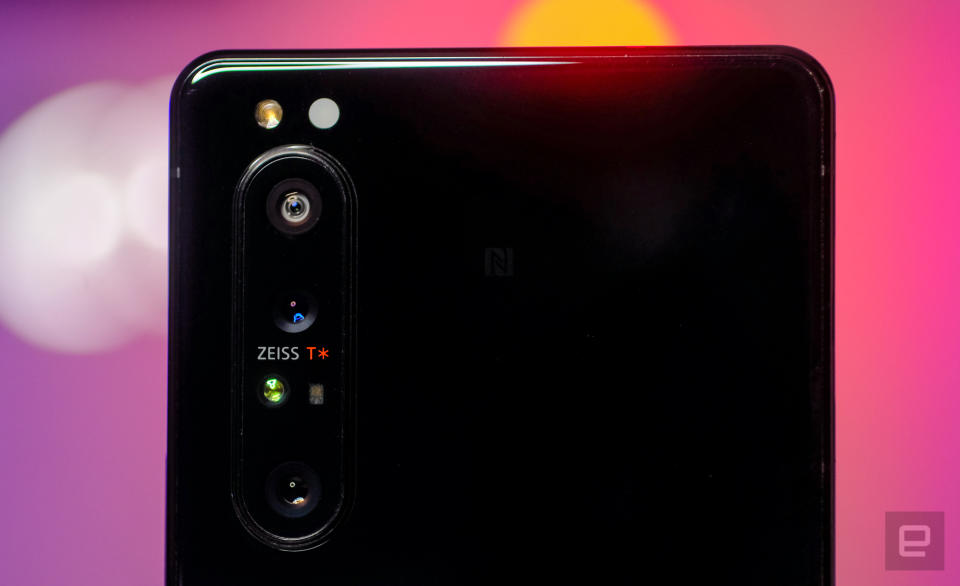
Lots of cameras, even more control
The Xperia 1 ii has a handful of cameras on its back, and it's worth working through them in order:
At the top is a 12MP ultra-wide-angle camera with an f/2.2 aperture and phase detection autofocus. It captures a 124-degree field of view with the equivalent of a 16mm lens, and there’s very little barrel distortion. It's reliable, though it’s the camera I use the least.
Next is the 12MP telephoto camera, with optical image stabilization and an f/2.4 aperture. It shoots at the equivalent of 70mm so it's very helpful for situations where you can't physically get closer to your subject, but results tend to be a little soft.
Here's the curveball: Sony wedged a 3D time-of-flight sensor in between its cameras. It's there to help with focus, but it only has a 15-foot range.
The star of the show is the 12MP wide camera. In addition to having an f/1.7 aperture, the sensor itself is physically larger than most, meaning it just gobbles up light. It's fantastic, and fares surprisingly well in low light even without a dedicated night mode.
There are a few interesting tidbits to note: For one, all these cameras are shielded by Zeiss's T* lens coating, which is designed to keep reflections and ghosting from fouling up your photos. And, despite making some of the most pixel-dense smartphone camera sensors in the world, Sony kept things pretty modest here. Not one of these cameras tiptoes over the 12MP threshold. Meanwhile, Samsung is running around, selling its 108-megapixel ISOCELL sensor to vendors like Huawei and Motorola.
One might assume that Samsung's cameras are superior, but the numbers never tell the whole story. Sony did a remarkable job squeezing everything it could out of these sensors and developed a suite of tools to help you do the same.
Let's start with video. Like the Xperia 1 before it, the 1 ii draws inspiration from Sony's CineAlta cameras. They're a mainstay of movie sets, not the vlogs you’re likely to run into on the street. If you're not shooting your thesis student film, you'll do fine sticking to the standard Camera app. It shoots in 4K, and the resulting footage looks pretty damn good. Sony's Cinema Pro app, meanwhile, offers a wealth of controls for people trying to capture a very specific vision.
The app lets you shoot 10-bit color video in either 2K at frame rates as high as 120fps, or the more standard 4K at 60fps. Want to dial in a specific ISO or shutter speed value? You can do that. What about cycling through a palette of video filters? Yep -- Sony's Venice filter is especially moody and atmospheric. Need to set focus manually? Go right ahead. You can even set the camera to perform a focus pull at the touch of a button, which comes in especially handy when you're, say, shooting a smartphone review video.
The Cinema Pro app is a great tool for anyone who wants more than just a point-and-shoot video experience -- it's feature-rich, but not too daunting. That’s not to say it’s perfect, though. Once you've decided what resolution you want to shoot in, though, you're basically stuck with it. The Cinema Pro app keeps all your footage organized by in separate bins by project, and the only way to change your resolution after you've started shooting is... by making a new project. In shooting with my video producer, Brian Oh, we noticed that it can also be surprisingly tough to get properly exposed footage, even when ISO is bottomed out at 64. And more than anything, I’m surprised Sony didn't add even more pro-grade features. Manual focus is a nice touch, but Sony has been doing focus peaking on its actual cameras for years, and it would've been a huge help here. Even LG figured that out years ago, on its V-series smartphones.
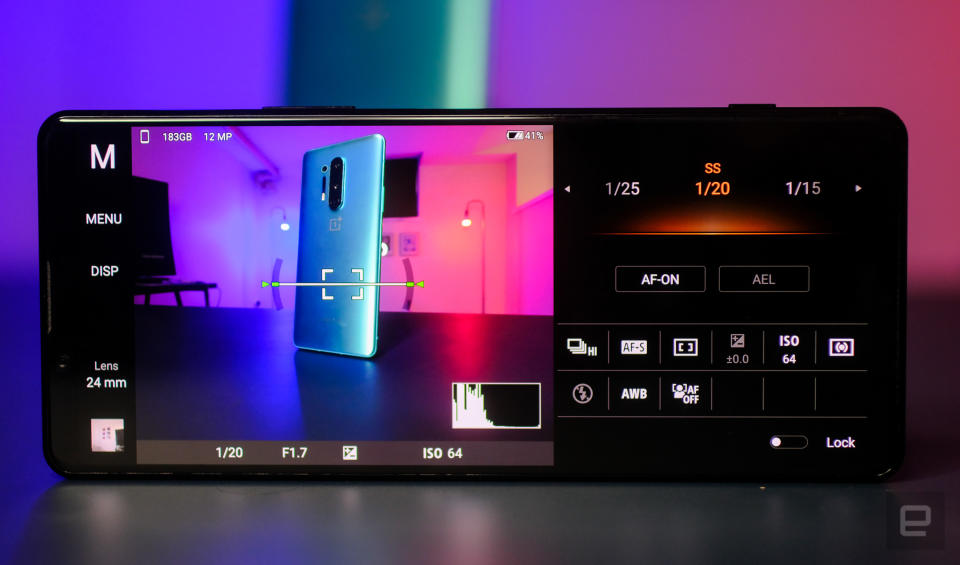
I'm much more of a photographer than a video person, though, so the many improvements Sony made to its still camera experience were more useful. Human eye-tracking debuted on the Xperia 1 and all but ensures you'll get a clean, crisp shot of a person's face, and the 1 ii expands that trick to work on animals too. I don't have a pet myself, but the feature came in very handy during a social-distanced hangout with a friend's adorable, somewhat Instagram-famous dog. The Xperia 1 ii's autofocus is also shockingly fast -- it performs focus calculations about 60 times per second, so it’s better at continuously locking onto a subject than any other phone I’ve used.
Best of all, Sony's choice of main camera sensor means you can shoot as many as 20 photos per second. For lack of anything more elegant to say, that is absolutely wild -- it's easily the most impressive thing about the Xperia 1 ii's camera system. But we'll get to that. We need to talk about the Xperia 1 ii's split camera personalities first.
For people who just want to point their phone at something and take a picture, it's pretty hard to recommend the Xperia. It offers controls to quickly switch between the three cameras, set your color temperature, and swap between a selection of artsy photo effects. And when you start shooting, the camera's scene detection generally does a decent job figuring out what you're looking at kicking to the right scene mode. If you're super tight on something, for instance, the camera automatically switches to macro. And when you’re shooting someone with light at their back — as is often the case over the summer — a Backlight Portrait mode does a marginally better job exposing their face.
The thing is, I generally never found the results all that exciting. You'll find lots of crisp detail and bright colors in photos taken with the main camera, though it very often overexposes bright scenes. The ultra-wide and telephoto cameras are situational utility players, but they mostly do their jobs without fuss. In other words, the pictures you’ll get out of the regular camera app are perfectly fine, but I can’t help but expect much more from a phone like this. It doesn’t help that the app itself feels more hamstrung than it should, either. The fact that this app lacks HDR entirely feels like a big miss, and you can't pinch to zoom between the three lens -- once the range of one camera butts up against the range of another you have to tap a button to switch between them.
All told, the standard camera experience isn’t bad, but there are two more caveats you should keep in mind. First, all of Sony’s clever camera work only applies to the Xperia 1 ii’s three rear sensors. The 8MP front camera is pretty terrible. Every selfie I took was slightly blurry and unsatisfying, even after I turned off the “soft skin” feature. (Hey Sony, this is a phone for photographers, right? Why not leave this off by default?) I don't begrudge Sony for focusing on its main cameras, but whiffing on a front-facing camera is just bad form for a device that costs as much as this does.
And second, if you're an off-the-cuff kind of photographer, this phone really isn't for you. I really can’t stress this enough. An iPhone 11 or a Google Pixel 4 will produce more immediately satisfying images, and they’ll ask very little from you along the way. That’s all thanks to their computational photography chops, which all but guarantee your photo looks great. Put another way, they’re safe.
But as any camera enthusiast would probably tell you, there is a very specific joy in locking in the right settings, waiting for the right moment, and capturing a photo you weren’t even sure was possible. Things don’t always work out, but the little adrenaline rush that comes with perfectly plucking a moment out of time is unlike anything else. And thanks to its Camera Pro app, the Xperia 1 ii is purpose-built to deliver those kinds of thrills.
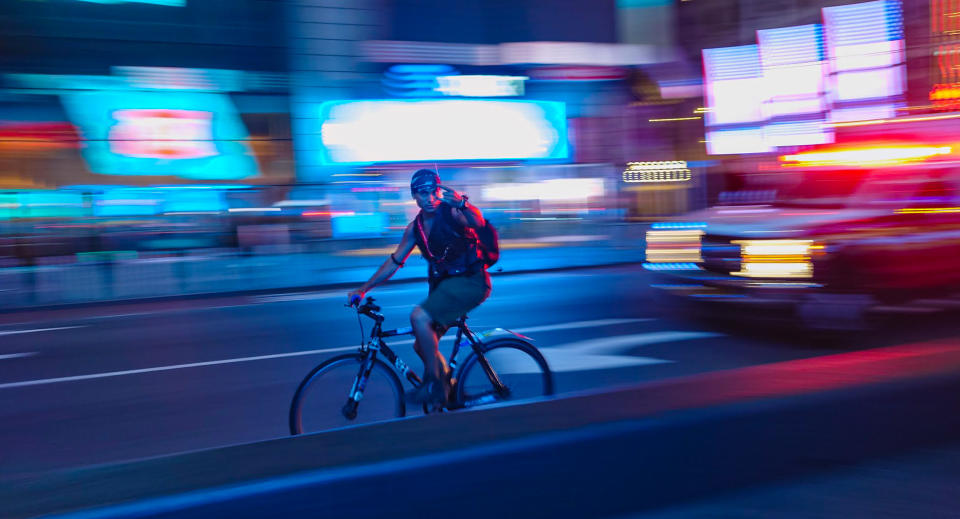
A few things to note: I shot this in Times Square at about 2:30 AM with the main rear camera, since it's the only one that can hit the 20 fps burst rate. When this cyclist was careening toward me, I couldn't make out his face -- it was only after I reviewed the photos that I noticed his expression, his gesture, and that splash of black nail polish. I also kinda guessed at the settings; someone with a stronger background in photography would've done even better.
Shortly afterward, I shot this:
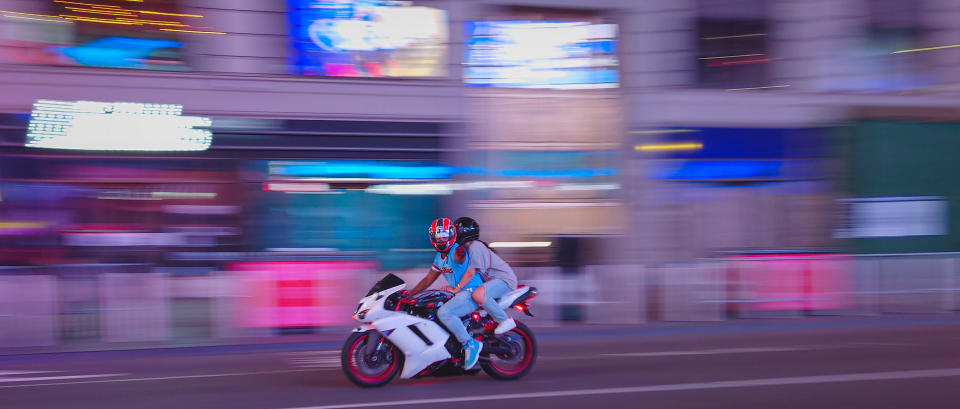
By that point, I was reeling. I hadn't had this much fun with a smartphone camera since I trekked out to a chilly beach to shoot the stars with a Pixel 4. But, with the Pixel, I marveled at what Google's software could do for me. With the Xperia, I marveled at what I was able to capture for myself.
Those photos simply wouldn't be possible without Sony's camera expertise, and the level of control the Camera Pro app provides. With settings for the camera's drive mode, shutter speed, focus area, ISO, metering mode, histogram, and more, Camera Pro can feel daunting in a way the Cinema Pro app doesn't. I could easily see some people getting discouraged by the complexity and layout of these controls. I certainly was, for the first few minutes at least.
Familiarity with detailed camera settings will be helpful for anyone looking to get the most of the Xperia 1 ii, but it’s not a requirement. As I said, the Xperia 1 ii only really makes sense if you care first and foremost about the camera experience -- you don't need to be an expert for that to be true. Calling me an amateur would be generous, but I had a blast out in the wild shooting what I think are some pretty great photos.
Wrap-up
You have to respect a device that wasn't designed to be a people-pleaser. And the Xperia 1 ii’s charm derives directly from how niche it is. It has a screen meant for movie nerds. Its cameras are meant for film and photo nerds. And thankfully, it’s more than solid in all the other departments that matter, like performance, battery life, and overall software quality.
In other words, it’s a fascinating mix of general competence and high-octane geekery. For people who relish the thrill of creation, the Xperia 1 ii will tend nicely to the basics while catering to your obsessions. And for everyone else? It's a fantastic phone that probably just isn't right for you.

